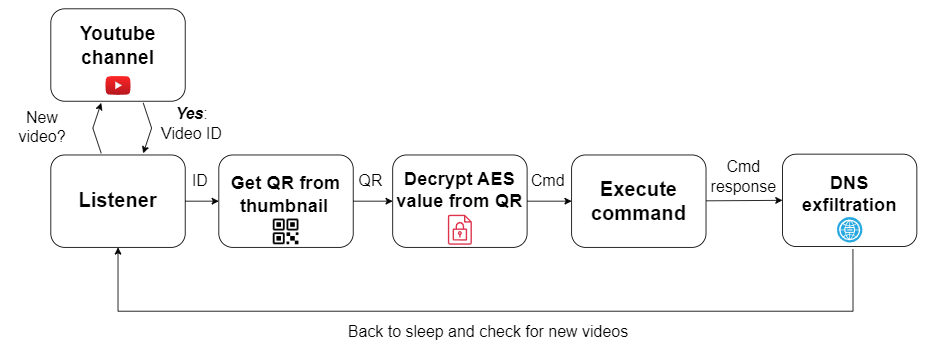SharpCovertTube - Using Youtube as covert channel
A program to control Windows systems remotely by uploading videos to Youtube, using C# for the listener and Python to create the videos. The QR codes can be in cleartext or AES-encrypted values.

Repository: https://github.com/ricardojoserf/SharpCovertTube
Usage
Run the listener in your Windows system:

It will check the Youtube channel every a specific amount of time (10 minutes by default) until a new video is uploaded. In this case, we upload “whoami.avi” from the folder example-videos:

After finding there is a new video in the channel, it decodes the QR code from the video thumbnail, executes the command and the response is base64-encoded and exfiltrated using DNS:

This works also for QR codes with AES-encrypted payloads and longer command responses. In this example, the file “dirtemp_aes.avi” from example-videos is uploaded and the content of c:\temp is exfiltrated using several DNS queries:

Logging to a file is optional but you must check the folder for that file exists in the system, the default value is “c:\temp\.sharpcoverttube.log”. DNS exfiltration is also optional and can be tested using Burp’s collaborator:

Configuration
There are some values you can change, you can find them in line 17 of Program.cs file for the regular binary and in SharpCovertTube.cs file for the service binary. Only the first two ones need to be updated:
- channel_id (Mandatory!!!): Get your Youtube channel ID from here.
- api_key (Mandatory!!!): To get the API key create an application and generate the key from here.
- payload_aes_key (Optional. Default: “0000000000000000”): AES key for decrypting QR codes (if using AES). It must be a 16-characters string.
- payload_aes_iv (Optional. Default: “0000000000000000”): IV key for decrypting QR codes (if using AES). It must be a 16-characters string.
- seconds_delay (Optional. Default: 600): Seconds delay until checking if a new video has been uploaded.
- debug_console (Optional. Default: true): Show debug messages in console or not.
- log_to_file (Optional. Default: true): Write debug messages in log file or not.
- log_file (Optional. Default: “c:\temp\.sharpcoverttube.log”): Log file path.
- dns_exfiltration (Optional. Default: true): Exfiltrate command responses through DNS or not.
- dns_hostname (Optional. Default: “.test.org”): DNS hostname to exfiltrate the response from commands executed in the system.

Generating videos with QR codes
You can generate the videos from Windows using Python3. For that, first install the dependencies:
pip install Pillow opencv-python pyqrcode pypng pycryptodome rebus
Then run the generate_video.py script:
python generate_video.py -t TYPE -f FILE -c COMMAND [-k AESKEY] [-i AESIV]
-
TYPE (-t) must be “qr” for payloads in cleartext or “qr_aes” if using AES encryption.
-
FILE (-f) is the path where the video is generated.
-
COMMAND (-c) is the command to execute in the system.
-
AESKEY (-k) is the key for AES encryption, only necessary if using the type “qr_aes”. It must be a string of 16 characters and the same as in Program.cs file in SharpCovertTube.
-
AESIV (-i) is the IV for AES encryption, only necessary if using the type “qr_aes”. It must be a string of 16 characters and the same as in Program.cs file in SharpCovertTube.
Examples
Generate a video with a QR value of “whoami” in cleartext in the path c:\temp\whoami.avi:
python generate_video.py -t qr -f c:\temp\whoami.avi -c whoami
Generate a video with an AES-encrypted QR value of “dir c:\windows\temp” with the key and IV “0000000000000000” in the path c:\temp\dirtemp_aes.avi:
python generate_video.py -t qr_aes -f c:\temp\dirtemp_aes.avi -c "dir c:\windows\temp" -k 0000000000000000 -i 0000000000000000

Running it as a service
It is also possible to run it as a service with the code in the SharpCovertTube_Service folder. It possible to install it with InstallUtil, it is prepared to run as SYSTEM so you need to run it as administrator:
InstallUtil.exe SharpCovertTube_Service.exe
You can then start it with:
net start "SharpCovertTube Service"

Notes
-
File must be 64 bits!!! This is due to the code used for QR decoding, which is borrowed from Stefan Gansevles’s QR-Capture project, who borrowed part of it from Uzi Granot’s QRCode project, who at the same time borrowed part of it from Zakhar Semenov’s Camera_Net project (then I lost track). So thanks to all of them!
-
This project is a port from covert-tube, a project I developed in 2021 using just Python, which was inspired by Welivesecurity blogs about Casbaneiro and Numando malwares.